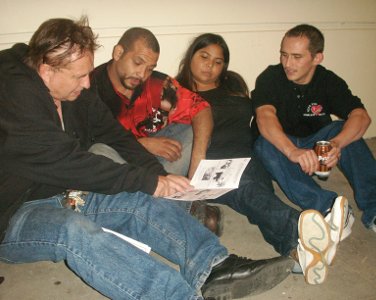
“They’re a product of the breakup of the American family,” he says. “More of them are throwaway than runaway. Some love the freedom, but most have been abused and rejected.”
(Photo: Clayton Golliher with homeless youth in California)
Experts estimate 1.5 million youth live on our nation’s streets; each year 5,000 will die of suicide, homicide and accidental drug overdose, and at least 40 percent are not wanted at home. One in four will visit Hollywood.
Golliher says they are prime targets for drug dealers, pimps, porno filmmakers and gang leaders. They hang in “families” as dysfunctional as the ones nearly all of them left. They often rotate “turning a trick” (male and female) to buy the group a one-night motel room.
Based at the Los Angeles Dream Center, HHY operates as a separate nonprofit and houses up to 50 single men and women, including Christian youth in its intern program. Young people up to 25 years old need only show up to gain three days’ emergency shelter.
Xocia Martinez, 20, is a former homeless “cutter.” When Martinez was an infant, her mother left; but when she was 16 her father remarried, problems arose, and Martinez went to live with her mother. She began using and selling drugs and became promiscuous. Depressed, she says she tried to overdose, and when that failed she used razors to slice her arms and legs.
“Cutting myself was a form of suicide,” she says, showing the scars. “Cutting was a way I could control all the pain I felt. It was better than any drug. I loved to see my blood run and drop to the floor.”
Two days after she arrived at HHY she accepted Christ as Savior and today receives personal counseling, attends five Bible studies and chapel services weekly, takes parts in outreaches, and works in the ministry’s office. She plans to attend ministry school and start a home for abused girls.
Sadly, many homeless youth prefer to remain on the streets. During a weekly HHY feeding in a Santa Monica Park, Gina, 23, eats a cheeseburger and talks. At age 13, with her father in jail and her mother dealing and using drugs, she hit the streets. She says she has been raped three times, twice on the streets and once at age 5.
“My own body was taken away from me. It changed my life forever,” she says.
She says her 6-year-old son lives with his father’s family in Vermont. “I carry around stuffed animals just to remind me of him,” she says. When offered emergency shelter and a bus ticket to Vermont, she says her new “husband” won’t join her. Instead, she plans to go to Tempe, Arizona-another homeless-youth enclave-and buy a house so her son can come there.
“I’m really not different because I live on the streets,” she insists. “I just have to work harder to survive.” Still, she takes a ministry card.
Golliher says homeless youth will call, sometimes in the middle of the night, after being robbed, beaten or raped. He always goes if it means getting one into his shelter.
The next day Golliher rises at 7 a.m., feeds a half-dozen youth in McDonald’s and visits the courtyard of a nearby Catholic Church. Some 40 people sit on folding chairs, waiting for food and showers. Golliher walks to the front with 17-year-old disciple Koby Bustillos.
Koby tells how his dad is in jail and his mother’s whereabouts are unknown. Both of them dealt the meth they were addicted to.
At 14 he was hooked and dealing. He lifts his shirt to show scars from a near-fatal stabbing.
Koby says that after enrolling at HHY he begged his best friend to join him. He didn’t, and two weeks later the 16-year-old was shot to death in a drive-by.
“I would have been with him if I wasn’t here,” he told the group. “And I love doing what I do now because it’s what Jesus wants. I plan to always be a man of God.”
It’s 10:30 a.m. and the team goes home. Golliher’s day will end after the afternoon services in two resident programs for parolees. Another team will be back in Hollywood Saturday night at midnight to give roses to transsexual prostitutes.
For the Hollywood outreach, Golliher records eight conversions. None of the eight people come back with him. He isn’t deterred.
“You know,” he says grinning, “I feel the presence of Jesus Christ more at night on the streets than I do in the best of church services.”











































